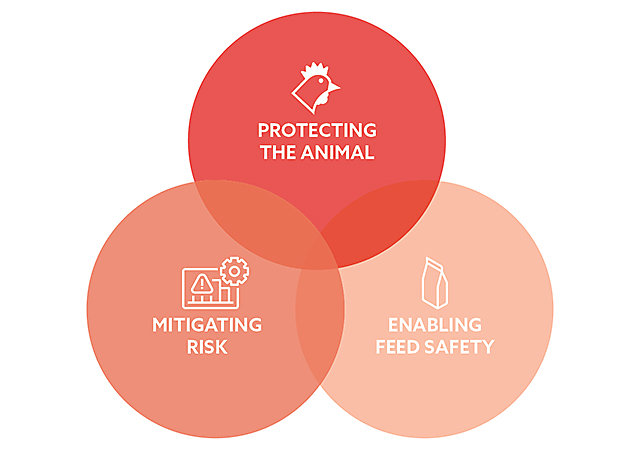For many years, it was believed that ruminants were less susceptible to the negative effects of mycotoxins. It was assumed that most mycotoxins were detoxified in the rumen. However, new research has proven otherwise.
Mycotoxin control is in fact crucial for the health and performance of animals since mycotoxins contaminate all agricultural ingredients, especially silages which are often a prominent source of mycotoxins.
Mycotoxins cause reduced feed intake, alter ruminal fermentation and reduce milk yield, alter reproduction, and cause damage to the liver, kidney, and gastrointestinal system. Mycotoxins such as aflatoxin and T-2 cause immune suppression impacting vaccination efficiency and making ruminants more susceptible to diseases.
It’s important to know that DON, Nivalenol, Ochratoxin, and T-2 are considered to be metabolized in the rumen to less toxic metabolites. However, the emerging mycotoxins, often present in silage, such as Enniatin B, Mycophenolic acid (MPA) and Roquefortine-C remain unchanged and toxic for ruminants. Furthermore, ZEA is metabolized to an even more toxic compound, affecting reproductivity. Aflatoxin is metabolized in the rumen to aflatoxin M1 — a serious concern for human health as it’s excreted in animal milk.
Note that the above is the case in a healthy cow, however, if a cow suffers from SARA (sub-acute rumen acidosis), a highly prevalent disease in cows, the picture changes. DON and nivalenol, as well as the emerging mycotoxins, are not metabolized anymore and remain toxic. Once they enter the intestine, some of them — MPA, ZEA and NIV for example — have very cytotoxic effects and compromise intestinal integrity, meaning the ruminant’s predisposition for enteric problems and diseases.
Unfortunately, mycotoxins do not only affect ruminants, they also affect human health — in fact, some mycotoxins and their metabolites are also excreted in milk, especially aflatoxin M1 (AFM1), which is carcinogenic.
What is more, is a general underestimation regarding the effects of mycotoxins in ruminants. At Kemin, our research shows that this is because of:
- Incorrect sampling due to the occurrence of hotspots;
- Masked mycotoxins — mycotoxins bound to components in feed, such as sugars, escape analyzes but remain toxic to the animal;
- Emerging mycotoxins are not routinely analyzed, especially those present in silages.
Learn more about Mycotoxin Management in our brochure





